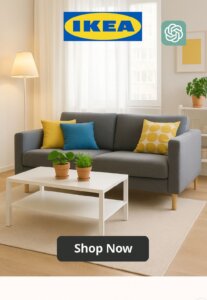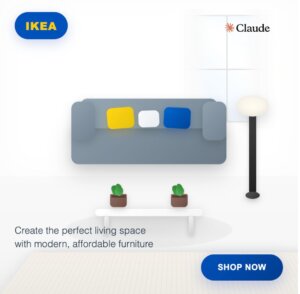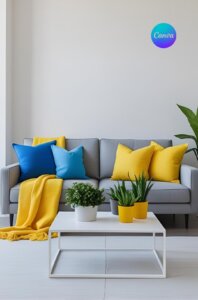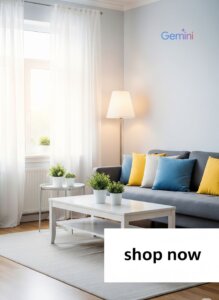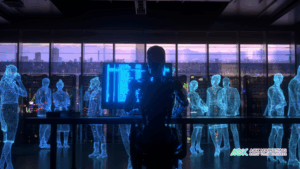Same prompt. Four AI tools. Very different results.
With the continuous rise of AI-generated design, we wanted to answer a simple question: Can artificial intelligence create a compelling Instagram ad? Specifically, one that aligns with modern brand aesthetics, delivers visual clarity, and motivates a click.
To find out, we gave the exact same prompt to ChatGPT, Claude, Gemini, and Canva—four of the leading AI tools that now include image generation or design capabilities.
The Prompt
Here’s what we asked each tool to create:
“A bright, minimalist IKEA living room with pops of yellow and blue. A modern gray sofa with colorful throw pillows sits center stage, paired with a sleek white coffee table decorated with potted green plants. A warm floor lamp casts a soft glow, while sunlight filters through sheer white curtains. The space feels airy, inviting, and ready to be lived in. (Plus a ‘Shop Now’ button.)”
A simple prompt, right? Clean. Specific. Marketable.
Our goal was to evaluate how each tool interpreted the direction—not just in terms of visuals, but also brand tone, execution quality, and platform readiness.
AI Tool #1: ChatGPT
Design Summary:
ChatGPT’s image felt photorealistic, warm, and lived-in. The furniture layout followed the prompt almost exactly—gray sofa, white coffee table, yellow and blue throw pillows, sheer white curtains, and warm natural lighting.
The IKEA brand logo was placed prominently, and the “Shop Now” button was visually clear and well-positioned.
Strengths:
-
Very on-brand for IKEA.
-
Clean composition and realistic styling.
-
Strong visual storytelling—this looked like a real lifestyle ad.
-
Seamless blend of Scandinavian simplicity and product focus.
Weaknesses:
-
Slightly traditional in layout—safe, not experimental.
-
The OpenAI logo (top right) may unintentionally distract from the ad’s core CTA.
Verdict:
ChatGPT delivered a polished, Instagram-ready ad that feels like it came straight out of IKEA’s creative department.
⭐ Score: 9/10
AI Tool #2: Claude (Anthropic)
Design Summary:
Claude opted for a vector-style, almost flat illustration of the room—think IKEA catalog meets modern digital art. The layout echoed the prompt well: sofa, plants, pillows, floor lamp, and window all appeared in simplified form.
The graphic had a soft, modern minimalism that might appeal to design-forward audiences. Claude also included the IKEA logo and added its own brand mark subtly in the corner.
Strengths:
-
Playful and abstract—feels modern and UI-friendly.
-
All prompt elements are technically present.
-
Feels unique among typical social ads; could stand out in-feed.
Weaknesses:
-
Lacks depth and realism—might not evoke emotional warmth.
-
Less likely to drive immediate shopping behavior without a real product image.
-
Minimal shadows or lighting give it a slightly static feel.
Verdict:
Claude’s design is artful, stylized, and may appeal to creatives. But in terms of conversion-oriented visuals, it feels more conceptual than commercial.
⭐ Score: 7.5/10
AI Tool #3: Canva (Magic Media Tool)
Design Summary:
Canva’s output leaned into bright, high-contrast lifestyle imagery. The gray sofa was crisp, the blue and yellow elements vivid, and the greenery popped beautifully. Its balance between photo realism and brand-like cleanliness was impressive.
There was no “Shop Now” button, which deviated slightly from the prompt, but the image still felt like an ad—just not a clickable one.
Strengths:
-
Visually stunning—great color contrast and layout.
-
Evokes emotion and seasonal energy.
-
Could easily serve as organic or paid content with minor tweaks.
Weaknesses:
-
No CTA button limits its performance as a direct-response ad.
-
Over-reliance on plant decor may slightly overcomplicate the minimalist brief.
Verdict:
Canva’s visual quality is undeniable. With a “Shop Now” button, it could have easily tied for first. As is, it’s more content-worthy than conversion-optimized.
⭐ Score: 8.5/10
AI Tool #4: Gemini (Google)
Design Summary:
Gemini gave us something that looked algorithmically designed to please Pinterest. Warm light, balanced layout, and a very cozy yet Scandinavian aesthetic. The image hit most of the prompt’s details—curtains, table, sofa, plants, etc.—and even included a “shop now” block in a clean, modern font.
Gemini also inserted its logo in the upper-right corner (perhaps unintentionally), echoing Claude’s visual branding placement.
Strengths:
-
Soft, aspirational design that fits wellness and lifestyle brands.
-
Strong use of white space and symmetry.
-
Calm, inviting—perfect for interior design content or native ads.
Weaknesses:
-
Slightly less emphasis on the bold colors (yellow/blue) than the prompt called for.
-
CTA isn’t styled like a button—might not attract enough taps.
Verdict:
Gemini’s design whispers rather than shouts. But for audiences looking for calm and comfort, it’s a subtle and effective visual.
⭐ Score: 8/10
Side-by-Side Comparison
| Tool | Realism | Prompt Accuracy | CTA Clarity | Brand Feel | Overall Score |
|---|---|---|---|---|---|
| ChatGPT | ✅✅✅ | ✅✅✅ | ✅✅✅ | ✅✅✅ | 9.0/10 |
| Canva | ✅✅✅ | ✅✅ | ❌ | ✅✅✅ | 8.5/10 |
| Gemini | ✅✅ | ✅✅ | ✅ | ✅✅✅ | 8.0/10 |
| Claude | ✅ | ✅✅✅ | ✅✅ | ✅✅ | 7.5/10 |
So… Which One Would You Click On?
All four tools had access to the same prompt—but their outputs tell us a lot about how differently AI interprets brand tone, visual detail, and user intent.
-
If you’re looking for product realism with a strong CTA, ChatGPT is your best bet.
-
For stylized creativity, Claude offers a fresh take.
-
If visual appeal is your top priority, Canva nails it with its signature polish.
-
And if you want something serene and editorial, Gemini quietly does the job.
Each tool reflects its maker’s core values—OpenAI’s realism, Anthropic’s simplicity, Google’s restraint, and Canva’s design polish.
Final Thoughts
AI is not just a text tool anymore. It’s an art director, designer, and ad assistant rolled into one. The real takeaway here isn’t which tool is “best”—it’s that your creative direction matters more than ever.
Same prompt. Four AI tools. Very different results.
About The Author
Jana Legaspi
Jana Legaspi is a seasoned content creator, blogger, and PR specialist with over 5 years of experience in the multimedia field. With a sharp eye for detail and a passion for storytelling, Jana has successfully crafted engaging content across various platforms, from social media to websites and beyond. Her diverse skill set allows her to seamlessly navigate the ever-changing digital landscape, consistently delivering quality content that resonates with audiences.
